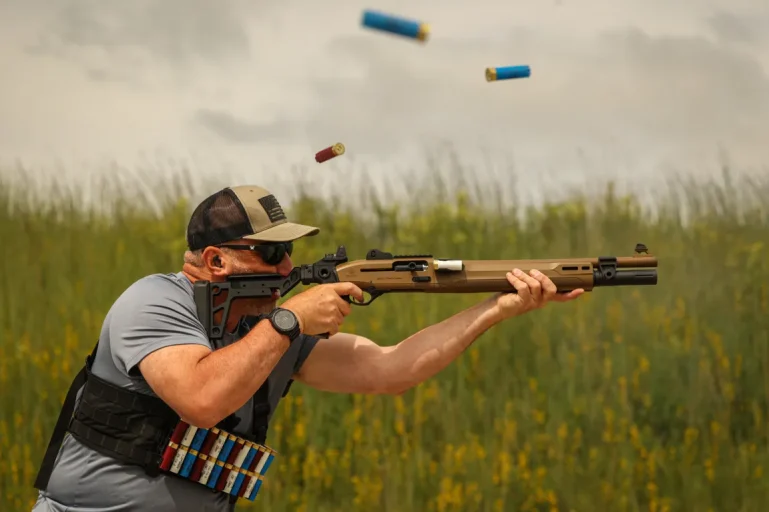
I was 10 when I first saw the movie Born on the Fourth of July.

Yep I was too young but then again, censorship wasn’t that stringent back then. Heck we could watch TV shows with blood in it almost anytime of the day in those days.
Oh yeah, I got pretty traumatized because of those grisly images on the TV.
But that’s not really what this article is for.
It is inspired by it though.
You see, I’ll be talking a little about home defense tools.
I take home defense very seriously.
It’s something I was exposed to at a very young age back in Siocon when at 9 or 10, I was shown the armory where my grandfather kept guns because there was a threat that rebels were going to attack the town.
Had that happened, I would have had to defend myself in case they invaded our home.
At 10.
I bet that added to the childhood trauma.
But then again, at that age, I was kind of naïve and I wanted to handle the impressive .45 calibre. I was immediately berated and told I would need training for that because that required accuracy. My inexperience would just lead to wasted bullets.
Instead, I was lead to an old looking shotgun that I was assured would hit anyone in front and to the side of me if they come near enough. I could even close my eyes and I’d still be able to hit them.
I was shown how to load the big red bullets in it. Two at a time and had a visual demonstration of how to pull the trigger.
I was extremely scared and excited during that time.
In hindsight, I should’ve asked to go home to Tacloban immediately and never go back to Siocon.
What is Home Defense?
Home defense is about keeping your family and property safe while minimizing risk. As a doomsday prepper, this is extremely important because when TEOTWAWKI comes and the SHTF, well you can only rely on yourself and your immediate family to protect what’s yours.
Choosing the right tool depends on your home layout, local laws, your comfort and training, and whether you prefer lethal or non-lethal options.
Below is a practical, safety-first guide to common choices — what makes them useful, their limitations, and important legal and safety reminders.
The Big Picture: Strategy Before Hardware
Before picking a weapon, ask yourself: can threats be prevented or deterred?
Good lighting, strong doors and locks, visible alarm signs, window security, and community awareness are often the most effective first line of defense.
If you decide to include weapons in your plan, treat them as a last-resort layer, and make safety, training, and legal compliance top priorities.
Shotguns — the Classic Home-Defense Tool
This, obviously, is my first choice.

I don’t intend to engage in combat outside the home so, I pick a shotgun as a last resort weapon if and when the adversary is determined to break into my home and take what’s mine.
Shotguns (commonly 12-gauge pump actions) are popular for home defense because they are simple to operate, deliver a wide spread at short range, and have strong stopping power.
The auditory and visual presence of a shotgun alone can be a strong deterrent. Pump-action models are reliable and mechanically straightforward.
Pros
- Effective at close range with high stopping power.
- Wide pellet spread reduces the need for pinpoint accuracy in high-stress situations.
- Simple operation and robust reliability.
Cons
- Significant recoil can be challenging for smaller or inexperienced users.
- Potential for over-penetration in populated areas — pellets or slugs can pass through walls.
- Physical size may make maneuvering in tight hallways difficult.
A shotgun is suited for households with members who are trained and comfortable handling a larger firearm and who have considered safe storage and the risk of over-penetration in close quarters.
Compact Handguns (e.g., Glock-style pistols)
My secondary weapon would be a Glock. These compact semi-automatic pistols are lightweight, easy to store, and are practical for homeowners who want a handgun for concealed carry or bedside access.

Models commonly recommended for reliability and simplicity include many striker-fired pistols; Glocks are frequently mentioned because of their reputation for durability and simple controls.
Pros
- Compact and easy to store/access.
- Lower recoil than many shotguns (depending on caliber).
- Higher magazine capacity in many models.
Cons
- Require training for safe, effective use under stress (reloading, clearing malfunctions).
- Higher chance of missed shots under stress unless regularly practiced.
- Risk of over-penetration depending on caliber and ammunition choice.
I don’t intend to brandish this weapon as a visual deterrent. This is strictly a point and shoot if and when the enemy comes too close for comfort.
Non-Lethal Options — Tasers, Pepper Spray, and Others
Since I am averse to using lethal weapons as a first line of defense on the farm, I have a few non-lethal options.
Non-lethal tools can stop or slow an intruder without causing permanent harm, and they can be preferable where legal, ethical, or safety concerns about firearms exist.
Tasers / Conducted Energy Devices
- Deliver an electrical charge intended to temporarily incapacitate. They can be effective at short ranges and create an opportunity to retreat or call for help.
- Limitations: Effectiveness can vary depending on clothing, distance, and the assailant’s physical condition. They also have legal restrictions in some places.
Pepper Spray / Mace
- Easy to use, inexpensive, and effective at disabling an aggressor’s vision and respiratory function for minutes — enough time to escape or secure a room.
- Limitations: Wind and confined spaces can blow spray back at the user; it requires aiming accuracy and has limited range.
Stun/Impact Devices & Slingshots
- Stun batons and impact tools can deter an intruder at very close range. Slingshots deliver small projectiles and are low-tech, but they require significant skill and are not reliable as a primary defense.
- Limitations: Close-quarter requirement and generally low stopping power compared to other options.
Other Practical, Non-Weapon Measures
But of course, weapons are a last means of defense. There are still things you can do that can act as deterrents or give you the tactical advantage to evade full-frontal contact.
The best way to win a fight is not to engage in one. I mean that’s just me as a practicing pacifist.
- Reinforced doors, deadbolts, and security film on windows reduce forced entry.
- Motion-activated lights, cameras, and monitored alarm systems deter intruders and provide evidence.
- A “safe room” or lockable bedroom can protect family members until help arrives.
- Dogs can alert occupants and deter intruders, though they are not a substitute for a security plan. I suggest dachshunds. These are mean little things that, if trained properly, could attack as a pack.
Training, Storage, and Legal Considerations — non-negotiable
If you decide to keep defensive tools in the home, these are essential:
Training
- Seek certified instruction for any firearm or device. Training should include legal use-of-force principles, safe handling, and realistic stress drills (non-live where appropriate).
- Regular practice builds competence and reduces the chance of accidents.
Safe Storage
- Store firearms unloaded in a locked safe or lockbox, with ammunition stored separately.
- Use trigger or cable locks as additional safeguards, especially if children or unauthorized people live in or visit the home.
Legal Compliance
- Laws about ownership, carrying, storage, and use of lethal and non-lethal weapons vary widely. Know your local and national laws, including self-defense statutes and reporting requirements.
- Certain devices (some tasers or sprays) may be prohibited or restricted in your area.
De-escalation & Aftermath
- The goal is to protect life and avoid unnecessary harm. When possible, prioritize escape and calling authorities.
- Understand the legal and emotional consequences of using force. Even lawful defensive actions can have serious legal and psychological aftermaths.
Choosing What’s Right for Your Home
There’s no one-size-fits-all answer. A practical approach:
- Start with prevention: locks, lights, alarms, neighbor awareness.
- If adding a defensive tool, weigh lethality, capability, and your willingness to train and secure it.
- Prioritize legal compliance and safe storage.
- Invest in training and routine practice.
Defense is about preparation and restraint.
For many families, a mix of sensible physical security (locks, doors, alarms), a non-lethal option (pepper spray or a Taser where legal), and, if chosen, a responsibly stored firearm with formal training, offers balanced protection.
Whatever you choose, treat safety, training, and the law as the top three priorities — everything else flows from them.

